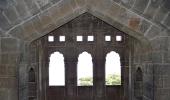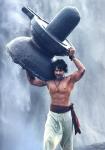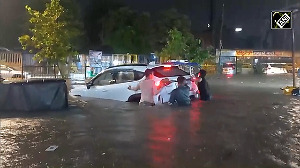Dr Sanjeeth Peter, a cardiac surgeon and an avid birder, voyaged to a remote but memorable part of Mizoram, bordering Myanmar, to find handsome birds he had never seen before.
While tracking down these feathered friends, he met Joy and Fortitude. Courage too. And he discovered several more treasures of Mizoram to embrace through 2024 and beyond.

March is never too late in the new year to enumerate and write about the events which stood out in the previous year -- my 2023 trip to Mizoram tops my list.
Finding birds in India that I have not seen is becoming more and more difficult. Locating and covering the last few species is going to involve journeys to remote and perhaps difficult lands.
So, when my good friend and birding buddy Major General Bhupesh K Goyal (winner of both the Vishisht Seva medal and the Ati Vishisht Seva medal), who has seen a few more Indian bird species than me, suggested going to Mizoram in the first week of November, where we were likely to get six 'lifers' -- a term used by birders for birds they are seeing for the first time in their life! -- I jumped at the opportunity.
Barely making it to the airport after a day of long surgeries, I realised I had not done any reading about our trip. I was sure Bhupesh would've done that, as he always does.

When met excitedly at Aizawl that afternoon, he animatedly described an image of the setting sun the previous evening from the Officer's Mess and asked me to run up the stairs to soak in the view too.
Once in the car, he asked if I knew what to expect. I jokingly said, "That's in your to-do list!"
"Oh! I don't know! Let's ask Joe," was his reply. Joe Thanga, our tour operator in Aizawl, had arranged the logistics and was personally driving us.
Rofikul Islam, perhaps the most talented birder in the North East was accompanying us as our group leader. "That's very unlike both of you not to know!" exclaimed Rofikul.
Joe explained that we would spend the night at Hmuifang Tourist Resort and leave early morning towards Sangau, a village at the foothills of the Blue Mountain (in Phawngpui National Park), home to the bird species we wished to see.
The drive to Sangau would be about 12 hours and the walk up to the mountains was a treacherous seven-hour trek, carrying with us our photographic gear for clicking birds on the way. We were spending two nights in the mountains. It would be cold, but hopefully no rain.
"I hope I'm physically fit for this trek!" I remarked.
Bhupesh said "Well! I'll see how it goes!"
"What do you mean?" I asked.
He went on to explain that he had a fall two days before while cycling and had excruciating pain on the left side of his chest. He had considered an x-ray, but when the pain subsided with a tablet of diclofenac and a cup of piping hot tea, he ignored it. When, on the day he was to leave, it pained enough to need help to even get up, he considered calling off the trip. But the enthusiasm of getting six lifers (and I suspect the opportunity of birding with me!), and the magical effect of another dose of diclofenac was enough to confirm his travel plans.
"So, it still hurts, especially when I sneeze or cough!" he explained as I listened, amazed at his perseverance.


We left just before sunbreak. Joe drove us to our first birding stop nearby.
It wasn't long before we got what we had come there for --- our first two lifers. A spot-breasted laughing thrush and a brown-crowned scimitar babbler.
We reached Sangau late that evening. Over the hills we could see the villages in Myanmar, whose border was a few km away. The sunrise over the Myanmar hills was stunning as we approached Thaltlang village, at the foot of the Blue Mountain.
It was 5 am and we expected to reach the forest guest house up in the mountains by 2 pm (considering we'd be birding on the way up).

Our next lifer was the perfect stimulus to excite us to go on -- a spot-throated babbler, another gem of Mizoram.
As we climbed further, we soon encountered a flock of birds. Amongst them was our fourth unexpected lifer -- a rufous-crowned prinia.

Just when we were about to give up, exhausted after trekking up the steep hill for four hours, we were met by an elderly man sitting on a small rock on the side of the narrow path. His smile was so welcoming and encouraging and when he held out a packet and said in broken Hindi "Your breakfast," our exhaustion was forgotten!
Chhanukha was 72, but his toothless grin and weathered face gave the impression that he was much older. He had crossed us on his way down, when we were climbing up a few hours earlier. He walked down to Thaltlang, picked up our breakfast and had trekked up a difficult, shorter but steeper route to meet us at that point.
"Take your time, you have another four hours to go. I'll go up quickly and get lunch ready for you." he said as he sprinted uphill with a slight limp, leaving us breathless just watching him go.

We trudged up along the narrow trail looking for more of Mizoram's treasures.
When Rofikul stopped abruptly, snapped his fingers and looked back with a big grin, we knew he had found another marvel. Sure enough it was the Chin Hills wren babbler, our fifth lifer.
It was only the adrenaline that the wren babbler generated in us that saw us trek the last few km. We reached the forest guest house, and an inviting hot meal, by 1 pm -- rice, dal and some local vegetables which Chhanukha had prepared.
We slumped on the dilapidated sofas and it took us half an hour to muster the courage to get ready for evening birding.
Our next target was the Mount Victoria babax. We succeeded in spotting a small flock of them, but far away in some bushes in its special habitat, along the rocky cliffs. Disappointed, we trudged back to our accommodation.
"I think I need to rest." Bhupesh muttered and lay flat on the rickety bed.
The walk for the babax had helped me identify some good spots for night-sky photography. So, we set off for the night quest after dinner.


The Milky Way was popping out of the clear starlit night. Bhupesh and Rofikul wanted selfies with the wondrous galaxy!
So, when I finally settled down to begin the four hour-long photo shoot, Bhupesh remarked that he'd rather go rest and be ready for the next day.
I finished close to midnight, walked back on the path lit by the shining stars, enjoying the cool breeze and got into the rickety bed, hoping for a good day of birding on the morrow.


Everyone wakes up early in Mizoram, including the Sun which rises by 5! So after a quick cup of hot coffee with biscuits, we set off in search of our lifers, beginning with the babax.
Standing precariously at the edge of a steep cliff, we scanned the bushes almost 100 m below us. That's when we saw it. Sitting alone at the topmost perch, surveying its surroundings. A beautiful bird -- discovered only in December 2021 in these hills in India! -- it sat fidgeting as we marvelled at its beauty. Would it be kind enough to come closer to us?
As we sat hoping for it to fly up, it disappeared into the bushes.
But movement in the nearby tree caught our attention. The Hume's treecreeper. Another lifer! It was a classic Sally moment that immediately recalled Sally saying 'Alice is gone but I'm still here!' from pop band Smokie's Living Next Door to Alice!

So, Sally, I mean the Hume's treecreeper befriended us and posed like there was no tomorrow. But our mind was still on the babax.
Perhaps understanding our heart's desire, the Mount Victoria babax flew up right in front of us, looked enquiringly at we three, as if questioning our presence there.
It stayed for a mere five seconds, long enough for some memorable lifetime images. It happened too quickly, so we pleaded with it to come back.
After an hour's wait, we decided to look for another particular lifer also seen on this meadow.

As we made our way through the tall bushes, we came to a clearing where there was a mixed flock of small birds. "A grey-crowned warbler!" Rofikul called out.
"Lifer!" was our unanimous response and we got the eighth lifer of the trip, an unexpected one!



When we got back to the rest house, we were met with a "Did you get it?" from Chhanukha, who wanted to know.
Our smiles said it all and he said, "I knew you will get it!"

We bonded with Chhanukha over preparing lunch. We divided the chores -- the washing, cutting and cooking of the vegetables.
"Wow! You're doing heart surgery on the tomato!" laughed Rofikul, watching me slice tomatoes for a salad.
"I'm glad you didn't describe what I am doing!' chuckled Bhupesh, who is a gynecologist, as he chopped the potatoes.
But through those jokes and laughter, we ended up making a splendid meal.
One of the joys of being a doctor is that I get to help people with their ailments. Most often they're minor ailments, but enough to constantly nag the person. The small bunch of medicines that I always carry come in handy and I invariably come back from a trip having distributed all of them.
Chhanukha came and sat quietly next to me on the log where I was soaking in the afternoon sun. He brought me a cup of coffee, from a made-in-Myanmar pre-mix. I knew instinctively there was something on his mind. In response to my enquiring look, he said"'I fell and broke my right leg about 50 years ago."
"And?"
"They put a rod through my leg." He had a comminuted fracture of the tibia (when the lower leg bone snaps into three pieces or more), was put on external fixation (the external use of wires and screws), bone graft, skin graft and when the wound healed, the bone had to be fixed with a rod through the tibia. That explained his slight limp.
He made me palpate the rod through the skin at the upper end of his leg, just below his right knee and said, "It hurts sometimes when I bend my knee or when I kneel."
"Understandable!" I said and explained that all he needed to do was have the rod removed or cut short. It had been there far too long. The bone would have healed and removing the rod would do the trick. It would perhaps require more force than usual, but likely would be a short procedure and wouldn't hurt as it would be done under anesthesia.
He listened to me intently. I could see the gears clicking in his head as he made sense of what I was saying.
"It's not my specialty, but I'd be glad to arrange for this surgery at no cost at one of India's best hospitals."
After a few moments of silence, he said, "What needs to be done is that the doctors should take an x-ray and see how far the lower end of the rod is from the ankle. If there is sufficient gap, then they can just hammer the top end of the rod into the tibia. I wouldn't even need anesthesia!".
He had it all worked out. I sat in amazement at this wise man whose solution seemed so practical!
The long conversation we had after lunch was as warm as the afternoon sun which we had come out to soak in. His father owned this hill and bequeathed it to him. He reminisced fondly about his childhood when they would cross over a hill to shop or even play in the neighbouring villages of Myanmar.
He spoke dotingly of his children and grandchildren. Chhanukha proudly told us that his nephew was standing for the Mizoram Legislative Assembly elections on a ZPM ticket from the Lawngtlai East constituency.
Another cup of hot lal chai later, we got ready for the evening session of birding.
"Can you hear it?" Rofik asked even before we picked up our gear.
"Striped laughingthrush." Not a lifer, but a difficult bird to get in the open.


We walked up to the babbax cliff, hoping to catch a glimpse of it again, but instead we got the ninth lifer of the trip, a stripe-breasted woodpecker.
Some of the Little Black Numbers that were flying relentlessly in the vast space between the cliffs, on close scrutiny turned out to be dark-rumped swift, our tenth lifer! Even with 800 mm lens a pic of our tenth lifer was not possible, sadly.




The sunset on the Indian horizon was spectacular to say the least. The myriad colours that it painted, while it drowned into the hills, left us spellbound.
While I concentrated on setting up my camera to capture the breathtaking sunset, Bhupesh took one of the best candid shots of me on his iPhone.
I decided to take a 'startrails' shot with Polaris, the North Star.
Bhupesh said he'd go lie down to be adequately rested for the next day's trek down.


We set off at the crack of dawn to look for more beauties. Unusual birds were perched on a dry branch -- an eye-browed thrush and a grey-sided thrush. Our eleventh and twelfth!
Just as we packed up to climb down after lunch, Chhanukha walked up and said that he too would reach Sangau by nightfall. It was polling day the next day and he wanted to vote for his nephew -- show solidarity and support him.
The walk down was much easier and we reached in time to relish the lavish dinner that Mami had prepared. She was the lady cook and caretaker who looked after the resthouse at Sangau.
Chhanukha invited us to his home in Sangau. He insisted we meet the rest of his family and share breakfast. It was lovely meeting his wife, children and grandchildren. We devoured the hot delicious breakfast, prepared with warmth and love.
When we finally hugged and bade goodbye to Chhanukha, Bhupesh took off his hat and replaced Chhanukha's air force cap with it! Chhanukha was now sporting an Indian Army cap!

The excitement of the trip and the lively conversations with Joe and Rofikul kept me awake on our long drive back to Aizawl. Roadside bamboo shops, displaying packets of vegetables and fruit, caught my attention. Joe screeched to a halt at my "What are these?"
He explained, "Shops without shopkeepers." Farmers packed small bundles of their produce and put them on display in those bamboo shops. The price was written on each packet (or may be written on a piece of paper or scribbled with chalk on a slate) and a Money Collection Box is in each shop. You can select what you want to buy, calculate the amount to be given and put it in the box. If you need change back? Dip into the box!
I was flabbergasted! The concept and the honesty of these simple people left me speechless.
I did some shopping too... My new-found favourite was winged beans or star beans for salad and bought oranges and bananas for the way. I loved the experience of shopping at the nghah lou dawr, the local name for such shops.

After a night halt, we headed to the airport to catch our flights back from Aizawl. Bhupesh still had some discomfort and asked me to help him with his camera bag. (BTW, never ask a bird photographer the weight of his/her carry-on!). I offered him a pain killer and as I looked concerned, he said "Hurts much less. I think I'll get a CT scan done when I get back."
We went scouting for six lifers and ended up with 12! But that's not the reason why this trip counted as special. Going for a trip to have a good time, relax, enjoy, laugh, de-stress and not just to chase targets, has always resulted in discovering treasures at the end of such delightful experiences.
Like meeting Chhanukha was special. It's not the difficulties that he counts, it's the joys of working hard to make a living, bringing up family and being there for them that matters (he made sure he voted for his nephew, because every vote counts!). Incidentally, his nephew, a medical doctor, won and is now a member of the legislative assembly in the newly-formed ZPM government in Mizoram.
And learnng about a treasure like a nah lou dawr was amazing. It swelled my heart with joy and I realised that honesty is still considered an important virtue and I hope that with honesty, goodness, kindness, care will spread amongst us.

Bhupesh sent me his CT scan later -- two ribs were fractured, fortunately none displaced and no haemorrhages. It proved again that in order to achieve something difficult, hurdles have to be crossed. They can be crossed without constantly cribbing or complaining about them, but rather by focussing on the task at hand.
As we tear through 2024, I will keep these life lessons of 2023 from the trip, close to me:
a. Work hard, exude warmth and be rooted to the ground.
b. Trust people and create an environment of trust.
c. Bear difficulties with a grin and focus on the task in order to achieve.
Feature Presentation: Ashish Narsale/Rediff.com











